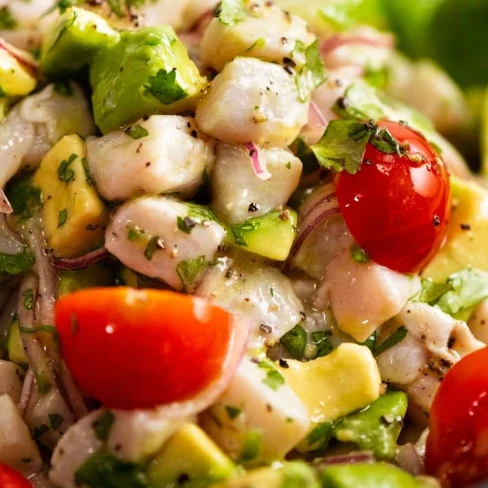Ceviche
Prep Time
10m
Cook Time
5m
Total Time
15m
This Ceviche recipe features raw, sashimi-grade fish marinated in lime juice, with red onion, jalapeño, cherry tomatoes, and avocado for added flavor and texture. A simple yet flavorful dish perfect for a light and refreshing meal or appetizer.
Ingredients
Steps
Nutrition Facts
Ingredients
(Servings:
5)
Scale
Scale
“cooked” Fish
Add Ins
Steps
View steps on recipetineats.com or by saving the recipe to your
personal library.
Register for free to start
saving recipes.
Nutrition Facts
Nutrition facts are based on 1 serving. If servings is not specified, 6 is assumed for the total
recipe.
-
Calories112kcal5%
-
Fat7g0%
-
Saturated Fat1g0%
-
Carbohydrates3g0%
-
Fiber2g0%
-
Sugar0g0%
-
Protein9g0%
-
Cholesterol12mg0%
-
Sodium248mg12%
Percent Daily Values are based on a 2,000 calorie diet.
Notes
1. Raw fish – virtually any raw fish can be used for ceviche, as long as it’s “sashimi-grade” / “sushi grade” and therefore safe for eating raw.Fish simply labelled as “fresh” is not always sashimi-grade, it just means it hasn’t been frozen. Always ask your fish monger, or ensure the fish is clearly labelled. Or make this with freshly caught fish!
Here is a non exhaustive list of some common and traditional fish varieties that are excellent for ceviche (see same list in post for more commentary on each):
Kingfish (pictured in post)- popular choice of fine dining establishments Sea bass– traditional in Peruvian Tuna and mackeral– popular in Mexico Prawns / shrimp – traditional in Ecuador, popular in Mexico Halibut or Patagonian tooth fish – Chile Salmon – not traditional but excellent for ceviche Bream – many species all around the world Swordfish – used in some Latin American countries. Trevally – not traditional in South America, but beautifully soft-textured and excellent for ceviche Cod and mahi mahi – Popular options in America.
Not recommended: snapper, grouper, some cods, flounder, which can be sometimes a bit tough eaten raw, are less suitable.
2. Salt – table salt is finer than cooking/kosher salt so use less.
3. Extra virgin olive oil – while not traditional, I find ceviche with just lime juice too sour for my palette, noting that limes in Mexico and South America tend to be less sour than those in Western countries.
Common to use oil in fine dining establishments. It also adds a touch of luxury to this dish while still keeping it super fresh. It’s essential, in my books 🙂
4. Leftovers – not recommended to keep leftovers for food hygiene purposes.
5. Nutrition per serving, assuming 5 servings (Ceviche only).
Here is a non exhaustive list of some common and traditional fish varieties that are excellent for ceviche (see same list in post for more commentary on each):
Kingfish (pictured in post)- popular choice of fine dining establishments Sea bass– traditional in Peruvian Tuna and mackeral– popular in Mexico Prawns / shrimp – traditional in Ecuador, popular in Mexico Halibut or Patagonian tooth fish – Chile Salmon – not traditional but excellent for ceviche Bream – many species all around the world Swordfish – used in some Latin American countries. Trevally – not traditional in South America, but beautifully soft-textured and excellent for ceviche Cod and mahi mahi – Popular options in America.
Not recommended: snapper, grouper, some cods, flounder, which can be sometimes a bit tough eaten raw, are less suitable.
2. Salt – table salt is finer than cooking/kosher salt so use less.
3. Extra virgin olive oil – while not traditional, I find ceviche with just lime juice too sour for my palette, noting that limes in Mexico and South America tend to be less sour than those in Western countries.
Common to use oil in fine dining establishments. It also adds a touch of luxury to this dish while still keeping it super fresh. It’s essential, in my books 🙂
4. Leftovers – not recommended to keep leftovers for food hygiene purposes.
5. Nutrition per serving, assuming 5 servings (Ceviche only).
